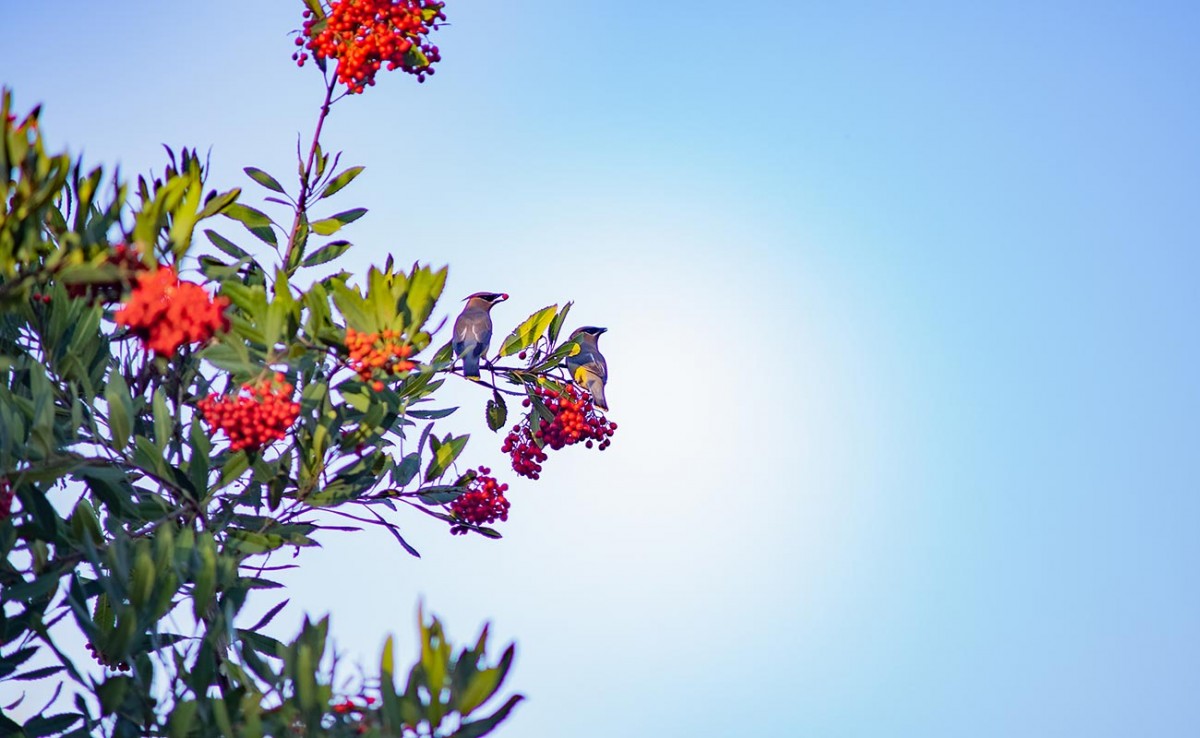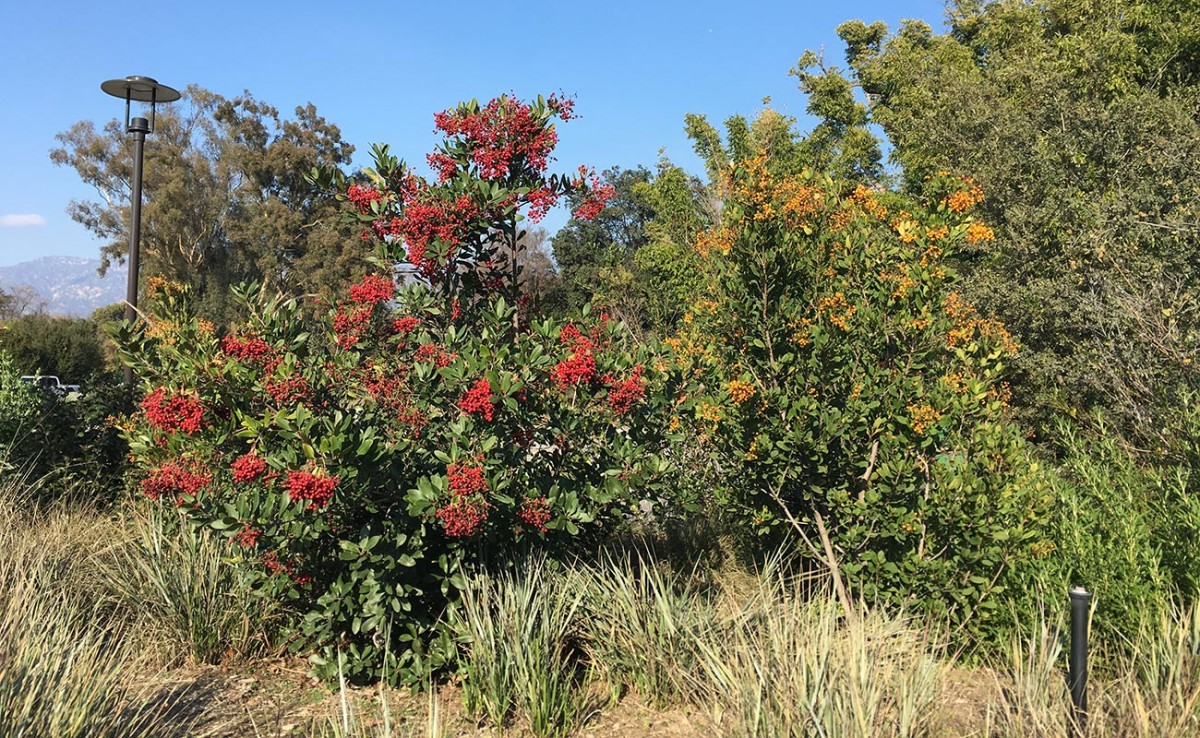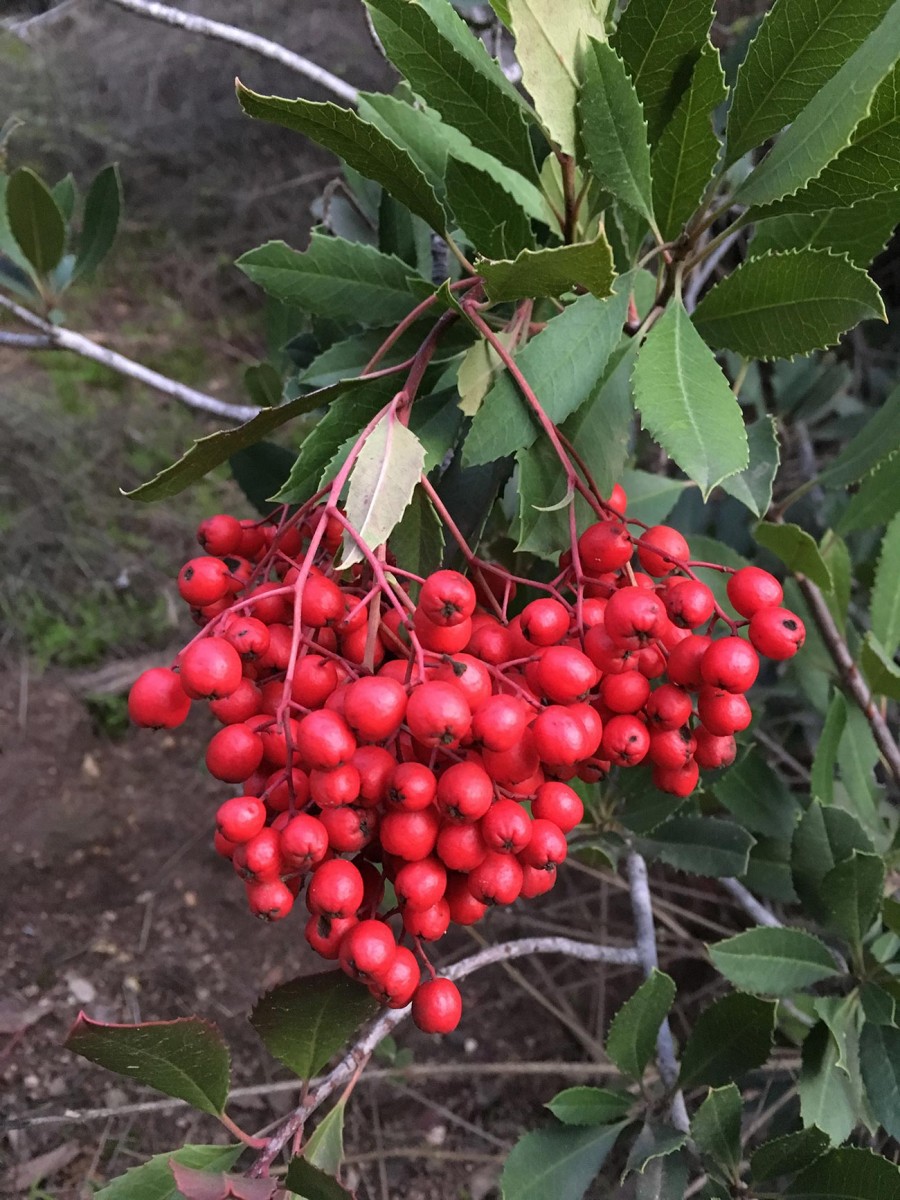The Huntington’s blog takes you behind the scenes for a scholarly view of the collections.
Chaparral Superstar
Posted on Wed., Dec. 8, 2021 by

Every winter, toyon plants produce an opulent banquet of berries that is a feast for the eyes and for local birds. Photo by Aric Allen.
Toyon is brightening winter landscapes throughout Southern California, including here at The Huntington. Also known as California holly, this native plant is producing a bounty of festive scarlet berries in several easy-to-spot locations: near the vehicle drop-off/pickup area next to Admissions, in the Steven S. Koblik Education and Visitor Center, as well as in the Stroll Garden and the Shakespeare Garden.
The Spanish derived the name “toyon” from the Ohlone and Chumash name for the shrub, “tottcon,” but subsequent settlers from the East Coast and Europe called it California holly or Christmas berry because it reminded them of the holly species they already knew. Many hollies are difficult to grow in California, and toyon—with its evergreen, serrated leaves and bright red berries—became a popular substitute for holly during holiday celebrations. In 2012, toyon was named the official native plant of Los Angeles, but this distinctive denizen of the City of Angels is no Hollywood diva.

Among the many bird species that flock to the bounty of toyon berries are cedar waxwings (Bombycilla cedrorum). Photo by Aric Allen.
The cast of characters that make up Southern California plant communities is full of such showy species as flannelbush (Fremontodendron), with its cascades of gleaming golden flowers; the glamorous Matilija poppy (Romneya), also called the “fried egg plant” because of its massive white blooms with sunny yellow centers; and manzanita (Arctostaphylos), striking evocative poses with its tortuous, mahogany-colored limbs. These tough beauties tolerate the long, dry summers, seasonal wildfires, and rainy winters that distinguish the climate of the Southwest. In fact, many are so well adapted to our climate that they can be tricky to grow in cultivation, where they may be expected to settle into a landscape alongside thirsty neighbors that demand water throughout the year or in soils that are not amenable to their needs. Enter handsome, resilient, flexible toyon.
Unlike many California natives that are adapted to our arid climate and will languish if watered regularly out of season, toyon will tolerate supplemental water throughout the year as well as a range of lighting conditions and soil types. Although it resembles true hollies from the genus Ilex, its leaves lack their spiny bite, making it friendlier to work with in garden settings.

Yellow-fruiting toyon plants also exist and are equally attractive in the landscape, though the red-berried form is dominant. Photo by John Trager.
Considered a shrub because of its bushy natural growth habit and size, toyon can be pruned and trained into a small tree form, clipped to serve as a hedge, or even (for the more ambitious gardener) espaliered to grow flat along a wall. Few pests are drawn to toyon, but its clusters of small white flowers are extremely attractive to a variety of pollinators, notably native bees. The profusion of bright red berries that follow the blooms are a reliable winter food source for wildlife, especially for such birds as cedar waxwings, American robins, mockingbirds, hermit thrushes, and finches.
Heteromeles arbutifolia, as toyon is known to botanists, is found almost exclusively within California in coastal scrub and chaparral areas from the northern border with Oregon south to the Baja California Peninsula and inland to the Sierra Nevada foothills. It was an important source of food, medicinal compounds, and wood for Indigenous peoples throughout its range.

After some yellow-fruiting toyons were discovered in wild populations, they were brought into cultivation. This cultivar is ‘Davis Gold’. Photo by John Trager.
The abundant toyon fruits look like berries but are technically pomes, as toyon is a member of the Rosaceae family, which includes apples, pears, and quince. Toyon fruits are mealy in texture, tart, and somewhat astringent, but exposure to heat dissipates the compounds that are the culprits. Indigenous peoples consumed toyon fruits in various ways. The fresh fruits could be made into a refreshing beverage; when sun-dried or roasted, they could be stored for later use, then cooked into a porridge or made into cakes. Settlers also prepared them as puddings and jellies.
A few years ago, a toyon with exceptionally dark berries was discovered on The Huntington’s grounds. Botanical staff collected cuttings and is currently seeing whether this selection has the potential to become a future introduction—to be named ‘Huntington Holly’. Cultivated varieties of plants, or cultivars, can be hybrids created by plant breeders or forms that initially appear as a result of the normal mutations that occur in all organisms. Humans may find a particular mutation desirable, so that plant is then selected and propagated to see if the mutation is stable and will reliably manifest in subsequent generations. It can take years to develop a cultivar.

This dark-berried form of toyon was discovered on The Huntington’s grounds and is currently being propagated to see if the variation in its fruit is stable. Photo by John Trager.
The potential star power of the ‘Huntington Holly’ remains to be seen, but when it comes to winter cheer, toyon is a perennial crowd-pleaser.
Sandy Masuo is the senior writer in the Office of Communications and Marketing at The Huntington.